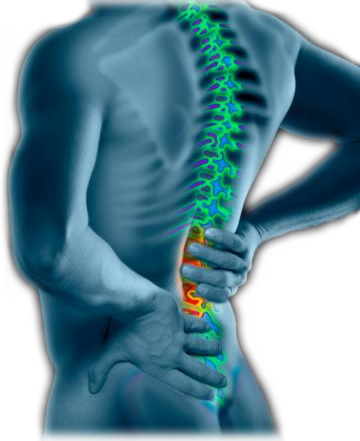Back pain - lower / upper and acute - causes, symptoms and treatment

What is Back Pain
Back pain - PAIN that arises from injury to the structures of the spine. Most back pain involves the soft tissue structures muscles, ligaments, tendons, and CARTILAGE. Back pain is very common, affecting nearly every adult at some time in his or her lifetime and is second only to HEADACHE as a reason for missing work. Though most back pain heals without residual consequences, chronic back pain (back pain that continues beyond three to six months) remains the leading cause of occupational disability.
Acute back pain develops suddenly, a consequence of traumatic injury or surgery, and improves when the underlying cause improves. The low back (lumbar spine) and the neck (cervical spine) are the most vulnerable to traumatic injury. Low back strain is a common injury often related to overuse, incorrect lifting (including lifting too much weight), and sudden twisting movements. Cervical strain often results from incorrect posture, especially prolonged sitting in the same position, or whiplash-type trauma in which the head moves suddenly and more rapidly than the body in a whipping fashion that stretches muscles and ligaments. Chronic back pain is pain that exists or continues when there is no pathologic reason and more often affects the low back.
Back PAIN with accompanying numbness or weakness in the legs may indicate damage to NERVE structures. Neck pain with FEVER or headache may indicate serious INFECTION (ENCEPHALITIS or MENINGITIS). These circumstances require immediate medical evaluation.
Symptoms of Back Pain and Diagnostic Path
Back pain, whether acute or chronic, may be sharp, dull, shooting, persistent, intermittent, or achy in character. The nature and location of the pain sometimes helps the doctor determine the cause. Most back pain results from soft tissue injury; unless there are neurologic symptoms, such as weakness or numbness in the legs or arms, the doctor may recommend a trial of conservative treatment before progressing to diagnostic testing. Pain that persists requires further diagnostic effort that may include X-RAY, COMPUTED TOMOGRAPHY (CT) SCAN, or MAGNETIC RESONANCE IMAGING (MRI). These imaging procedures help the doctor visualize the structure of the spine to determine whether there is deterioration or other injury that could be pressing on spinal NERVE roots and other structures of the back to produce pain.
Back Pain Treatment Options and Outlook
Most acute back pain improves with conservative treatment to relieve INFLAMMATION. Such treatment may include alternating heat and cold to the area of pain, ANALGESIC MEDICATIONS for pain relief, NONSTEROIDAL ANTI-INFLAMMATORY DRUGS (NSAIDS) to relieve inflammation and pain, and sometimes MUSCLE RELAXANT MEDICATIONS when MUSCLE spasms are a problem. Some doctors recommend a day or two of relative inactivity to allow the back muscles to rest and relax, though some studies show HEALING occurs more rapidly in mild to moderate back pain when people continue their regular activities (except strenuous exercise or heavy lifting).
Treatment for chronic back pain depends on what underlying reasons the doctor can identify that could be accountable. Complementary methods such as ACUPUNCTURE, various types of MASSAGE THERAPY, CHIROPRACTIC manipulation, and OSTEOPATHIC MANIPULATIVE TREATMENT (OMT) often provide relief. YOGA and PHYSICAL THERAPY are methods for improving FLEXIBILITY and STRENGTH after the initial injury heals.
Back Pain - Risk Factors and Preventive Measures
Key risk factors for back pain include occupational risk (jobs that require heavy lifting, pushing, or pulling), OBESITY, physical inactivity, and cigarette smoking. Most back pain occurs as a result of injury to the back, commonly strained muscles or sprained ligaments. Regular physical exercise to maintain strength and flexibility reduces the risk for such injury and aids in weight loss efforts when excessive body weight is a factor. Proper lifting technique and good posture are also important.
See also ACUTE PAIN; ANKYLOSING SPONDYLITIS; CERVICAL SPONDYLOSIS; CHRONIC PAIN; CONDITIONING LIGAMENT; OSTEOARTHRITIS; SCIATICA; SPASM; SPINAL CORD INJURY; TENDON.